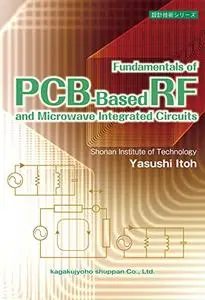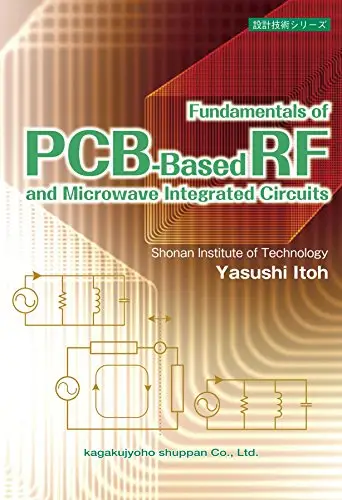Fundamentals of PCB-Based RF and Microwave Integrated Circuits by Yasushi Itoh
English | ISBN: N/A | ASIN: B07C1LBX5B | 237 pages | EPUB | 2018 | 19 Mb
English | ISBN: N/A | ASIN: B07C1LBX5B | 237 pages | EPUB | 2018 | 19 Mb
I.PCB-Based RF and Microwave Integrated Circuit Design
I-1 PCB
1. Structure
2. Substrate
3. Wiring
4. Fabrication
I-2 Passive Element
1. Lumped and distributed elements
2. Transmission lines
3. Lumped elements
I-3 Active Element
1. Transistor
2. Varactor diodes
I-4. RF connector
1. Variety of RF connectors
2. RF connectors suitable for PCBs
References
II. Circuit Design Using Lumped Elements
II-1. Smith Chart
1. Reflection, Impedance, Return Loss and VSWR
ii
2. Impedance Chart and Admittance Chart
3. Reading of Impedance and Admittance
II-2. Impedance Transformation and Matching
1. Reading the Value of Circuit Elements from Smith Chart (Single Element)
2. Reading the Value of Circuit Elements from Smith Chart (Dual Element)
3. Calculating the Value of Circuit Elements from Smith Chart (Dual Element)
II-3. Conjugate Impedance Matching
1. Conditions for Conjugate Impedance Matching
2. Calculation of the Generator and Load Impedances
3. Mismatch Loss
II-4. Circuit Loss and Quality Factor
1. Series RLC Circuit
2. Parallel RLC Circuit
III. 2-Port Networks
III-1. 2-Port Networks
1. Definition
2. Image Parameters
3. T-,π-, L- and Inverse L-Shaped Networks
4. Cross Transformation
iii
III-2. Image Impedance and Cutoff Frequency of the Filter Circuits
1. Low-Pass Filter (LPF)
2 High-Pass Filter (HPF)
IV. Circuit Analysis Using Lumped Elements
IV-1. Linear Circuit Analysis
1. Variety of Linear Circuit Analysis
2. Nodal Analysis and Mesh Analysis
3. Signal Flow Graph Analysis
4. Noise Analysis
IV-2. Nonlinear Analysis
1. Time Domain Analysis
2. Frequency Domain Analysis
3. Harmonic-Balance Method
4. Nonlinear Analysis Using AM-AM and AM-PM Performances
References
V. Evaluation Parameters and Measurements of the Transistor
V-1. DC Parameters
1. Bipolar Transistor
2. Gummel Plot
iv
3. Semiconductor Parameter Analyzer and Device Modeling Software
V-2. S-Parameter
1. S-parameter Measurement of the Surface-Mount Type Device
2. De-embedding
3. SOLT Method
4. TRL Method
V-3. Nonlinear Parameters
1. Large-Signal S-parameters
2. Nonlinear Gummel Poon Model
3. Load-Pull Measurement
4. X-Parameter
5. Nonlinear Analysis Using Behavioral Modeling
V-4. Noise Parameter
1. Noise Parameter
2. Noise Measurement
References
VI. Layout
VI-1. Substrate, Electronic Part, Connector and Layout of Pattern and Photo resist
1. Substrate
2. Electronic Parts
3. Layout of the Pattern
VI-2. Multi-Layer Design
1. Multi-Layer Layout
v
2. CAD Software for Drawing a Layout
3. Drawings of Layer
4. Output File Format
VII. Fabrication of the PCB-Based RF and Microwave Integrated Circuit
VII-1. Fabrication Tools and Parts
1. Microscope and Loupe
2. Soldering
3. Tweezer and Cutter Knife
4. Wire Stripper, Radio Plier and Cutting Nipper
VII-2. Fabrication Process
1. Fabrication Drawing
2. Mounting of the Electronic Devices on the Substrate
3. Machining of Connectors
4. Pre-Soldering
5. Soldering of the Electronic Devices on the Pattern
6. Soldering of the Connector
7. Visual Inspection
VIII. Passive Circuits Using Lumped Elements
VIII-1. Power Dividers and Combiners
1. Wilkinson Power Dividers and Combiners
2. Circuit Design
3. Circuit Simulation
4. Layout and Fabrication Drawing
5. Photograph
6. Measured Results
VIII-2. 90-Degree Hybrid
1. 90-Degree Hybrid
2. Circuit Design
3. Circuit Simulation
4. Layout and Fabrication Drawing
5. Photograph
6. Measured Results
VIII-3. 180-Degree Hybrid
1. 180-Degree Hybrid
vi
2. Circuit Design
3. Circuit Simulation
4. Layout and Fabrication Drawing
5. Photograph
6. Measured Results
References
IX. Active Circuits Using Lumped Elements
IX-1. Amplifier
1. Single-Ended, Low-Noise Amplifier Using a Common-Emitter Transistor
2. Input Circuit Design for Noise Matching
3. Circuit Simulation
4. Layout , Photograph and Measured Results
IX-2. Oscillator
IX-3. Control Circuit



